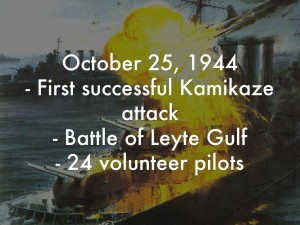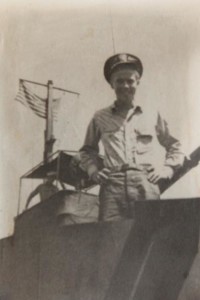Kamikaze Suicide Pilots Set Pattern for Later Political Underdogs
When terrorists brought down the World Trade Center and attacked the Pentagon in 2001, few news commentators made the comparison to kamikaze suicide pilots of World War II.
Since the kamikazes, however, suicide bombings have become the weapon of choice for political underdogs against dominant superpowers. Even the liberal talk show celebrity Bill Maher famously disagreed with President George W. Bush’s facile labeling of the terrorists as “cowards.” “We have been the cowards, lobbing cruise missiles from 2,000 miles away. That’s cowardly,” said Maher; “Staying in the airplane when it hits the building, say what you want about it, it’s not cowardly.”
 Japan might not have known that US codebreaking had doomed its forces at Midway and Saipan, but the Empire knew that it was now on the defensive. By the Battle of Leyte Gulf in October 1944, Japanese air power was gone, with too few planes and experienced pilots to provide necessary cover for its navy.
Japan might not have known that US codebreaking had doomed its forces at Midway and Saipan, but the Empire knew that it was now on the defensive. By the Battle of Leyte Gulf in October 1944, Japanese air power was gone, with too few planes and experienced pilots to provide necessary cover for its navy.
Kamikaze pilots made their debut at that time. Volunteers far outstripped the number of planes available. The country was isolated geographically and historically, boasting a blood-based unity and samurai trad ition that welcomed death in battle as the highest form of patriotism. The heartfelt Umi Yukaba song, based on an ancient poem, was sung by kamikaze pilots before their no-return take-offs.
ition that welcomed death in battle as the highest form of patriotism. The heartfelt Umi Yukaba song, based on an ancient poem, was sung by kamikaze pilots before their no-return take-offs.
The no-surrender, ready-to-die national bonding of the Japanese people with kamikaze pilots may well have saved the country from the horrific cost of homeland invasion, with millions of additional lives lost on both sides. In its prime, Christianity once was convinced that rewards would come in an afterlife in heaven, not unlike some of the radical jihadists today.
Had the US military known just how decisively it had won at Leyte, it seems certain that Iwo Jima and Okinawa would not have been necessary the following year.
 On Saturday, August 8, at EAFB’s South Dakota Air and Space Museum, you are invited (it’s free) to hear Harold Jansen of Rapid City talk about his experiences in the US Navy during World War II as the US sought to retake the Philippines during the Battle of Leyte Gulf, from 930-1130 am (social period from 9-930).
On Saturday, August 8, at EAFB’s South Dakota Air and Space Museum, you are invited (it’s free) to hear Harold Jansen of Rapid City talk about his experiences in the US Navy during World War II as the US sought to retake the Philippines during the Battle of Leyte Gulf, from 930-1130 am (social period from 9-930).  The photo shows Jansen in 1944 at the age of 21, as seen on a 200ft LCT (Landing Craft Tank). He bears personal witness to the kamikazes.
The photo shows Jansen in 1944 at the age of 21, as seen on a 200ft LCT (Landing Craft Tank). He bears personal witness to the kamikazes.
As an LCT vice-commander, Jansen was present at the final dramatic confrontation between a far superior Japanese battleship armada (all that was then left) and a lightly defended Leyte beachhead, with a hodgepodge of outgunned small ships bluffing away the enemy with will power and aggression.
 Japan might not have known that US codebreaking had doomed its forces at Midway and Saipan, but the Empire knew that it was now on the defensive. By the Battle of Leyte Gulf in October 1944, Japanese air power was gone, with too few planes and experienced pilots to provide necessary cover for its navy.
Japan might not have known that US codebreaking had doomed its forces at Midway and Saipan, but the Empire knew that it was now on the defensive. By the Battle of Leyte Gulf in October 1944, Japanese air power was gone, with too few planes and experienced pilots to provide necessary cover for its navy.  ition that welcomed death in battle as the highest form of patriotism. The heartfelt Umi Yukaba song, based on an ancient poem, was sung by kamikaze pilots before their no-return take-offs.
ition that welcomed death in battle as the highest form of patriotism. The heartfelt Umi Yukaba song, based on an ancient poem, was sung by kamikaze pilots before their no-return take-offs.  On Saturday, August 8, at EAFB’s South Dakota Air and Space Museum, you are invited (it’s free) to hear Harold Jansen of Rapid City talk about his experiences in the US Navy during World War II as the US sought to retake the Philippines during the Battle of Leyte Gulf, from 930-1130 am (social period from 9-930).
On Saturday, August 8, at EAFB’s South Dakota Air and Space Museum, you are invited (it’s free) to hear Harold Jansen of Rapid City talk about his experiences in the US Navy during World War II as the US sought to retake the Philippines during the Battle of Leyte Gulf, from 930-1130 am (social period from 9-930).  The photo shows Jansen in 1944 at the age of 21, as seen on a 200ft LCT (Landing Craft Tank). He bears personal witness to the kamikazes.
The photo shows Jansen in 1944 at the age of 21, as seen on a 200ft LCT (Landing Craft Tank). He bears personal witness to the kamikazes.